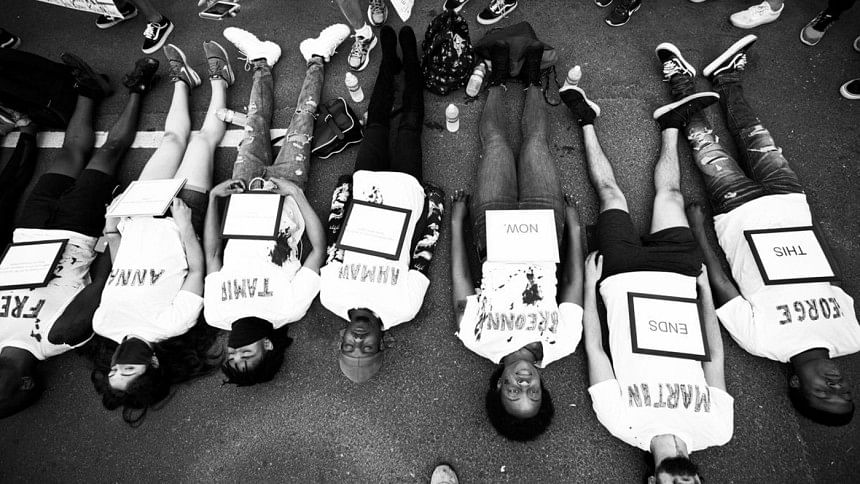We must confront organised violence with organised love

What does it mean to be nonviolent in a world full of horror and chaos, not to mention weapons and instruments of every kind created to inflict pain? Is nonviolence simply the absence of violence, a preference for order and lawfulness? If its purpose, as Martin Luther King Jr. once said, is to "develop a sense of shame in the opponent, and thereby bring about a transformation and change of heart" in them, how tactically correct is it when you face opponents who have no inhibitions about using force and no desire whatsoever to learn or sympathise? How long can you remain nonviolent, physically or internally, in the face of such overwhelming odds?
As we observe the International Day of Non-Violence today, these are questions that haunt nonviolent activists and strategists struggling to find an effective antidote to the injustices that abound in the world. Violence today is more structural and lawful, cloaked in the discourse of national interests. You get branded "unpatriotic" for peaceful protests against state action and policy. You get vilified for challenging the status quo, or not accepting the dominant narratives in blind faith. You get arrested or worse even for speaking up. This is a far cry from when the luminaries of the nonviolence movement put it at the centre of political action, asking followers to offer their body as a crucible for their oppressor's change of heart. Does it still work when you, for example, confront not just individuals but also a carefully crafted system of abuse built on the collective interest of its beneficiaries—which is unlikely to change regardless of what transformation individual oppressors go through?
Even Gandhi, whose legacy of nonviolence this day honours, was aware of the questions of practicality associated with this approach. But he was driven more by its spiritual possibilities (he called it "the first article of my faith") and less by what it offers in terms of dramatic solutions. To unpack his idea of nonviolence, one needs to understand what nonviolence is and is not. It is not passive acceptance of oppression, nor a mere rejection of violence. It is not for the fainthearted either. The Gandhian philosophy of nonviolence or civil disobedience as a driver of social change involves active and sustained participation in diverse peaceful methods that require both faith and patience on the part of the activists. "Nonviolence is not a garment to be put on and off at will. Its seat is in the heart, and it must be an inseparable part of our being," he said.
What this means in practical terms is that we must be patient, have faith in the humanity of ourselves and others and pursue wise strategies. But with the change of time and growing disillusionment with people's capability for revolutionary change, activists had to move the goalposts too. Changing hearts through a display of suffering is no longer a key objective. Meaningful change can come through targeting the system for which creative and compelling forms of nonviolent action are needed. American political scientist Gene Sharp likened this process to one of a combat situation that demands of its "soldiers" courage, discipline and sacrifice. "This view of nonviolent action as a technique of active combat is diametrically opposed to the popular assumption that, at its strongest, nonviolent action relies on rational persuasion of the opponent, and more commonly it consists simply of passive submission," he said.
As repressive regimes and pseudo-democracies around the world get more violent and resistant to change, nonviolent activists must also be equally persistent, defiant and combative. We need to "wage peace" harder than they wage war. But how?
The Covid-19 pandemic, among other things, has brought to a halt the unprecedented levels of mass mobilisation seen in recent years. Since the pandemic struck, there has been a near-cessation of mass demonstrations, rallies, protests, sit-ins and other such forms of street mobilisation. But this, according to a report by The Guardian in late April, does not mean that "people power" has dissipated. The writers of the report identified about 100 distinct methods of nonviolent action that include physical, virtual and hybrid responses that people are using to voice concerns, express solidarity and press for change.
The report described how people—many without leaving their homes—are adapting to remote organising, building their bases, sharpening their messaging, and planning strategies for what comes next. Among the various methods used are car caravans, cacerolazos (collectively banging pots and pans inside the home), walkouts from workplaces with health and safety challenges, free online medical-consultation clinics, mass donations of protective gear and sanitiser, pop-up food banks, community mutual aid pods and crowdsourced emergency funds, live-streamed readings, musical performance from balconies and rooftops, toolkits developed for civic action, drones adapted to deliver supplies, disinfect common areas, check individual temperatures and monitor high-risk areas, etc. "Many movements are moving their activities online, with digital rallies, teach-ins and information-sharing," it added.
And of course, there is then the Black Lives Matter movement which has been largely inspired by the peaceful civil resistance led by Martin Luther King, whose famous saying—"nonviolence demands that the means we use must be as pure as the ends we seek"—remains an important lesson for all followers in the tradition of nonviolent resistance. It's true that the Black Lives Matter movement has been undermined to some extent by isolated incidents of violence and rioting but it remains by and large peaceful to this day, despite many provocations.
It is impossible to predict the long-term effects of these initiatives but these are important reminders of flourishing people power in the midst of this global crisis. We have seen many of these new tools and forms of nonviolent action used in Bangladesh too. We have seen crowdfunded and volunteer rapid response led by individuals and social organisations to support disadvantaged groups. We have seen activists organising webinars and Facebook Live sessions to highlight critical issues that need to be changed. Many have launched initiatives against domestic violence by coordinating caring duties and mutual support. Many are also organising peaceful street protests for various causes, braving risks of infection as well as brutalities by police and elements associated with the ruling party. Private-sector actors have also come up with various measures to reduce sufferings. These are all different forms of what some activists rightly called "organised love", geared to express solidarity and demand appropriate action by the state.
Nonviolence is not just a way of life, nor a means to quick fixes. You don't claim to be nonviolent by simply refraining from a violent response. It's a political strategy to harness innate people power, to persistently demand change and do your part as a socially responsible being while pursuing creative methods geared to that end. Those frustrated by its apparent lack of teeth should constantly remind themselves of the time-tested virtues of peace, love and reconciliation as well as the potential of nonviolent action for affecting greater change, if utilised properly. The pandemic has taught us to be creative in that regard. Let's stick to that.
Badiuzzaman Bay is a member of the editorial team at The Daily Star. Email: [email protected]

 For all latest news, follow The Daily Star's Google News channel.
For all latest news, follow The Daily Star's Google News channel. 



Comments